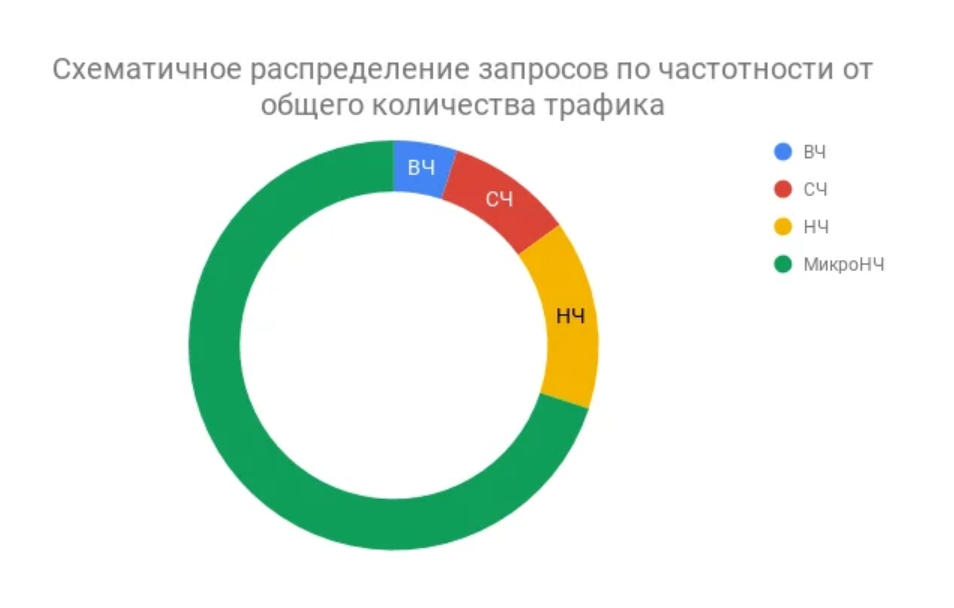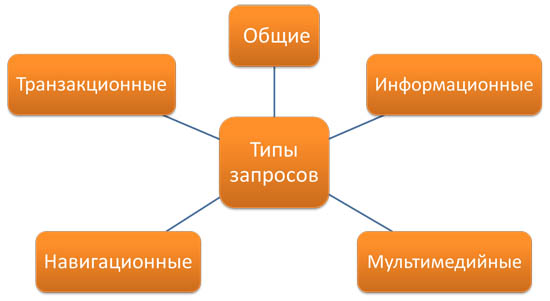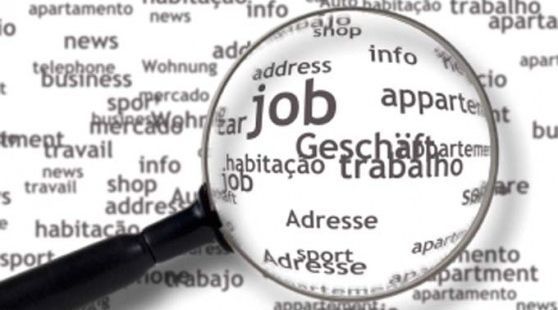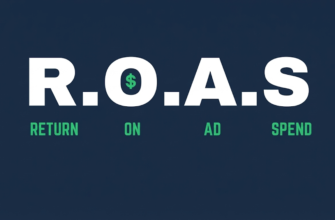When a user wants to get the necessary information on the Internet, he or she enters a certain word or a whole phrase – a search query – into a search engine. The system processes this query and produces a long list of web pages that match it.
Contextual advertising is shown to potential clients in accordance with their search queries. That is why a careful selection of keywords is made before launching an advertising campaign. When collecting a semantic core should be based on the standard classification of search queries.
In this article we will consider all the main types of search queries and highlight the phrases that should be paid special attention to when creating contextual advertising.
How many calls and sales will I get by ordering contextual advertising from you?
I need to calculate the conversion of my website Describe
the task
in the application
Calculate potential ad revenue Google
contextual advertising calculator
Types of search queries

By categorizing search queries, an advertiser can:
- Build a base of key phrases for his campaign;
- Increase the relevance of ads in accordance with the needs of the target audience;
- Manage the budget depending on the effectiveness of the keywords used;
- Work with potential customers at different stages of the sales funnel;
- Set up relevant advertising offers, focusing on the users’ intent.
The division of keywords into types is made taking into account such criteria:
Frequency

Frequency determines the number of inputs of specific key phrases for a set period of time. This concept is very relative. It is only considered on the basis of the business niche. For example, indicators in the sale of covers for cell phones and in the supply of parts for special vehicles will be completely different (in one area keyword phrase with a frequency of 100 requests / month will be low-frequency, and in another, where in principle there are few requests – high-frequency).
According to this criterion, the following types of search engine queries are distinguished:
- High-frequency (HF). These are the most popular and competitive queries, usually consisting of 1-2 words. For example, “buy a phone”, “tours to Turkey”, “apartment repair”. They bring a lot of traffic, but it is less targeted. The cost of a click in contextual advertising on HF queries is maximum, and it is much more difficult to move up in organics on them due to high competition. However, HF queries are necessary to reach a wider audience at the stage of attracting attention to a brand or product. They are suitable for image advertising or increasing recognition. And in some topics (e.g., entertainment, media) can give high conversion rates.
- Medium-frequency (MF). This is the best option in terms of traffic volume and conversion rate. They consist of 2-4 words and are more specific. This includes key phrases like “buy iPhone 12 Pro”, “turnkey apartment repair”. For SF is easier to promote in the organic output, and contextual advertising for them is usually cheaper. At the same time, they allow you to attract an audience that is already ready to buy. That’s why most companies put the main emphasis on LF in their marketing strategy.
- Low-frequency (LF). Maximum specific, consisting of 4 or more words – “buy iPhone 16 for 128 GB in Zhitomir”, “repair of one-room apartment 40 square meters turnkey”. When promoting on low-frequency queries, you can get minimal traffic, but the conversion will be the highest. They are used by those users who have already studied all the nuances of the advertised product or service and are ready for a targeted action. In PPC the price of a click on low-frequency keywords is low, and in SEO-performance you can reach the top as easily and quickly as possible.
- Micro low-frequency. These are the most detailed and longest queries that people enter very rarely. Examples: “buy iPhone 16 Pro 256 GB blue in installments at Rosetka”, “how to lay floor tiles on beacons by yourself”. The number of hits on such keys rarely exceeds 10 per month, and more often – close to zero. However, they can show good results in highly specialized niches or for local businesses in small towns. There is practically no competition for micro-frequency queries, and conversion is maximum.
- Inflated. These are key phrases with artificially inflated frequency. They are easy to calculate – the base frequency (the number of queries that include all words from the key phrase in any order) is approximately equal to the phrase frequency (the number of queries with the exact occurrence of the key phrase). If both frequencies are low (within 10), it may indicate that the same person entered these words several times. But if the base and phrase frequencies are equal and have high values, most likely, there was a “trickery” on the part of webmasters to get into the search cues.
By degree of competitiveness
Competition increases the complexity of setting up and running contextual advertising for certain keywords. The higher it is, the more expensive the advertising campaign will be.
There are such types of search queries by level of competitiveness:
- Highly competitive. These key phrases are considered the most effective, so they have a fairly high cost. Consequently, they can not be used with a limited budget advertising campaign;
- Medium-competitive. They include the bulk of keywords. These queries are actively used to promote sites, and for contextual advertising;
- Low-competitive. These keywords have a low price. However, to achieve the desired effect of the ad, they must be used in large quantities.
According to the value that can bring to the advertiser
In the classification of search queries is involved in this criterion, because it is used to assess the prospects of keywords for the project as a whole.
Types of search queries by value are as follows:
How many calls and sales will I get by ordering contextual advertising from you?
I need to calculate the conversion of my website Describe
the task
in the application
Calculate potential ad revenue Google
contextual advertising calculator
- Non-commercial. This variety includes informational keywords and phrases aimed at finding instructions for crafts at home (e.g., how to make, review, with your own hands, characteristics, etc.). These queries are used when creating useful content for users. They are not suitable for contextual advertising;
- Commercial. These are key phrases focused on purchasing products or ordering services (e.g., order, price, cost, buy, etc.). When they are used in contextual advertising, the site regularly receives targeted traffic.
By geo-dependency
Geo-dependence of a query is its binding to the location of users. Based on this factor, the following types of queries in search engines are distinguished:
Geo-dependent
These are queries that are explicitly or implicitly tied to a specific region, city or location of the user. Examples: “pizza delivery”, “beauty salon”, “refrigerator repair”.
For example, if a person from Lviv enters the query “call a plumber”, in which there is no obvious geographical marker, it is logical that the service is needed in Lviv, and not in Kharkiv.
For geo-dependent queries search engines first show the sites of companies from the same region as the user. The location is determined by the IP address of the device or account data (if the person is authorized). Also the regional character of the site and the presence of the physical address of the company influence the rendition.
Geo-dependent
They include all queries that have no geographical reference, or queries supplemented with toponyms. For example, “how to cook lasagna” or “buy a dishwasher in Dnipro”.
If for the first phrase the output will consist of informational sites of culinary orientation, then in the second example a person has already indicated a regional reference by adding a toponym to the key phrase. For such a key phrase output will be the same when searching from any region.
Seasonality

There are certain types of search queries that are related to a specific season or date, as well as queries that are relevant at any time:
- Trending. These are phrases that are in demand among users at a certain time: a year, a month, etc. Then the frequency of requests decreases. These words are related to some events (concerts, exhibitions, etc.). A characteristic marker for these queries is the year included in the query text.
- Seasonal queries. They are always connected with seasons or holidays. Their demand sharply increases with the onset of the season or a certain holiday date, then sharply decreases. For example, during Black Friday the traffic of online stores rises sharply. And before the opening of the ski season, requests for skates, skis, etc. increase. If you prepare in advance to launch an advertising campaign before these dates, you can get a large inflow of targeted traffic.
- Non-seasonal. These are phrases that are in demand at any time. Most of the queries to search engines refer specifically to non-seasonal ones. And seasonality is usually easy to determine from the meaning of the query itself.
By the number of words in the query
Classification of search queries by the number of words is no less relevant. According to it, queries are divided into:
- Single word queries. Since it is a single word, these queries are characterized by high frequency and competition. But the conversion rate will be low due to the vagueness of the wording. For example, a user typing in the query “pipe cleaning” may be looking for instructions on how to clean pipes on their own, as well as the corresponding service.
- Multi-word. They consist of several words. The more words there are in a query, the lower the frequency and competition will be. It is worth noting that more specific queries with a higher probability will help the advertiser to get conversion, because the client has already decided exactly what he wants to buy.
By relevance to the user
Another way to systematize search queries is to classify them according to the level of interest of users in a given topic. This type of queries in search engines helps to competently and effectively establish the process of budget management. For example, it is recommended to increase click-through rates for queries with the highest conversion rates and reduce them for all others.
The following types of search queries are distinguished:
- Hot. These are usually queries that reflect the customer’s strong desire to buy a product. They often include such words as: “buy”, “price”, “near me”, “order”, the name of the locality, and so on. Such ads allow you to get the highest conversion rate. For this reason, you should strive to take the top position in the ad block on the search engine. This will significantly increase the probability of conversion and clicks on the ad.
- Warm. Usually, requests with a medium frequency are considered to be warm. Users are interested in the offer, but are not yet ready to take advantage of it. For example, “white sofa”, “hare toy prices”, “gift for a girl” and queries on the range of competitors.
- Cold. These are queries characterized by high frequency. They consist of product names. Acceptable: “HP laptops”, “wrist watches”, “baby dolls”. To create ads taking into account these queries, it is necessary to correctly select “minus words” in order to avoid irrelevant displays. Therefore, you should not overestimate the click rate for them and fight for advanced positions in the output. This will not increase conversion anyway. Placement of ads on them is necessary in order to increase audience coverage and gather audience for remarketing. At the same time in the text of the ad specify in detail the terms of purchase of goods and delivery to screen out untargeted users.
The main types of queries in search engines

Depending on the user’s intent, search queries are categorized into:
- General. These are high-frequency keywords with an uncertain focus (e.g., clothes, dishes, car, toy, etc.). According to them, it is almost impossible to determine what exactly the user wants at the moment. Both informational and commercial web pages are displayed in the rendition for such queries. These key phrases have a low conversion rate, so they are not used for website optimization and contextual advertising;
- Multimedia. These queries are used to search the web for various media files – text documents, video and audio recordings, photos (e.g., Nirvana clip, desktop wallpaper, puppy videos, etc.). When launching an advertising campaign, such keywords are included in the list of minus-phrases. This allows you to avoid the arrival of untargeted traffic;
- Navigational. People use these keywords when searching for other sites (e.g., Facebook, my VKontakte page, Eldorado store, etc.). A type of navigational queries are vital, containing only the brand name without explanatory words (e.g. Huawei, Balmain, Jacuzzi, etc.);
- Informational. These queries are the most common on the Internet. Usually they are questions with the words “what to do”, “how”, “for what”, “why” (for example, why does a giraffe need a long neck, what to do if your laptop starts turning itself off, etc.);
- Transactional. Users enter these keywords, wishing to make a targeted transaction. These phrases include the words “download”, “buy”, “order” (e.g., buy a smartphone, order apartment cleaning, download Anti-Plagiarism program, etc.).
- Branded (vital). Such keywords a person uses when looking for a particular site or brand. For example, instead of “order pizza in Kiev” the user enters the query “order pizza Dominos”. This indicates a high interest in the goods or services of a particular company. Vital queries allow you to attract a target audience that is already familiar with the brand and shows loyalty to it. At the same time, advertising on them will cost much less compared to standard commercial traffic. However, for this to work, it is necessary that the company is already in the ear of the audience.
- Cartographic. Usually they are used by users who are looking for a way to get to a specific address or object. For example, “how to get to the operetta theater” or “cafe near me”. Here, Google Maps will usually be at the top of the search results. That said, getting into the search results for map queries is quite important for local businesses.
- Spectral. These include queries that have several meanings. For example, “Don Quixote” can mean both the ballet production, the original book, and the character himself. “Banks” can mean both financial institutions and glass containers. Getting to the top for such queries depends on additional context and more rare qualifying keywords on the page.


















